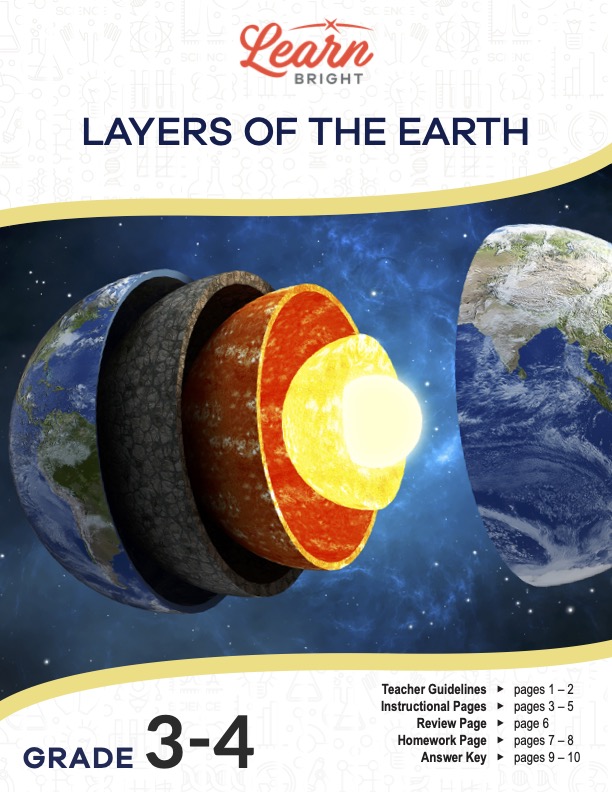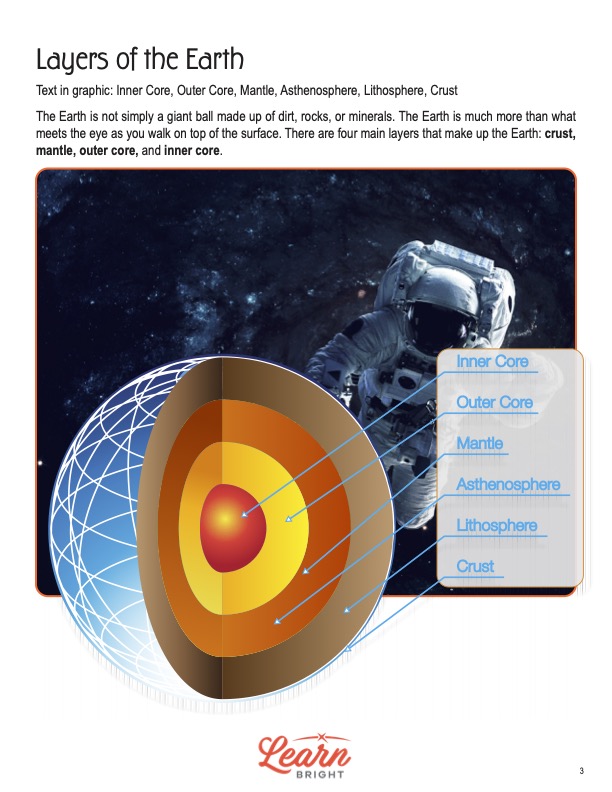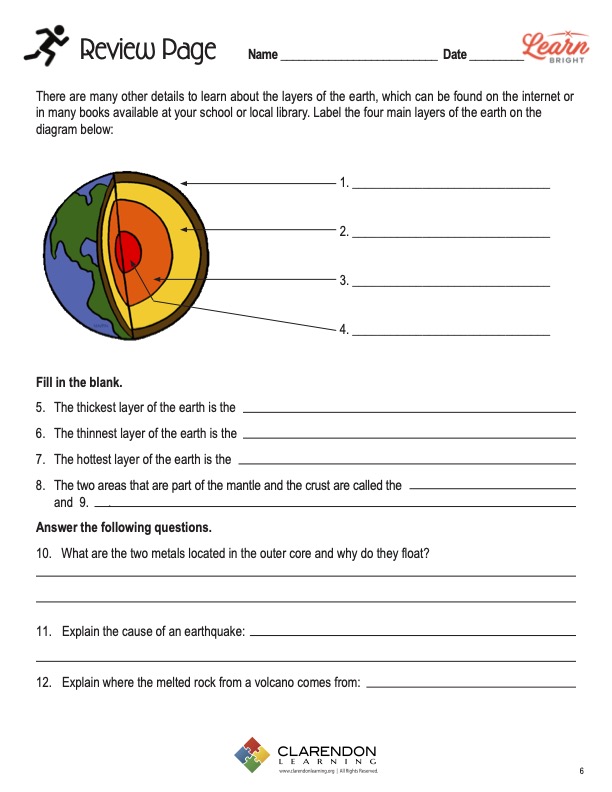Description
What our Layers of the Earth lesson plan includes
Lesson Objectives and Overview: Layers of the Earth describes the Earth’s four main layers and their characteristics. Students will be able to identify the crust, mantle, outer core, and inner core based on their traits. They will also learn a little about the lithosphere and asthenosphere layers. This lesson is for students in 3rd grade and 4th grade.
Classroom Procedure
Every lesson plan provides you with a classroom procedure page that outlines a step-by-step guide to follow. You do not have to follow the guide exactly. The guide helps you organize the lesson and details when to hand out worksheets. It also lists information in the yellow box that you might find useful. You will find the lesson objectives, state standards, and number of class sessions the lesson should take to complete in this area. In addition, it describes the supplies you will need as well as what and how you need to prepare beforehand. This lesson plan doesn’t require any supplies, but it will require some prep ahead of time.
Options for Lesson
The “Options for Lesson” section offers a few suggestions for additional activities or alternative ways to approach certain aspects of the lesson. One idea is to use different sized balls split in half for the lesson opening rather than using clothing pieces. Alternatively, you could halve fruits instead and let students eat them after you finish the opening. Another option is to switch the worksheets and use the puzzle as the in-class work and the review page as the homework assignment. If you need to save time, do not display the number pages and adjust the part of the lesson that involves those pages.
Teacher Notes
The paragraph on this page provides additional insight into what to expect. This lesson has no additional information to provide. The lines on this page are for you to write down whatever ideas and thoughts come to mind as you prepare the lesson for your students.
LAYERS OF THE EARTH LESSON PLAN CONTENT PAGES
The Layers of the Earth lesson plan contains a total of three pages of content. To start out, the lesson explains that the Earth is not simply a giant ball of dirt, rocks, and minerals. On the contrary, our planet is much more than meets the eye as we roam around on its surface. There are four main layers that make up the Earth: crust, mantle, outer core, and inner core.
We are quite familiar with the first layer, the crust, since we walk on it every day, dig holes in it, and so on. It is the outer layer of the Earth and is actually between 5 and 25 miles thick depending on location. Under the oceans, it is only about 3 to 5 miles thick, and we refer to these areas as oceanic crust. Under continents, however, the crust reaches up to 25 miles thick, and we refer to these parts as continental crust. The temperatures of the Earth’s crust can range anywhere between air temperature and 1600°F, which is hot enough to melt rocks!
This thin layer consists of broken pieces called plates, which float on top of the soft mantle layer below. (The movement of these plates is what often causes earthquakes.) The mantle layer is the largest at about 1800 miles thick. It is comprised of extremely hot, dense rock and flows like asphalt. The temperature at the top is about 1600°F, but it’s about 4000°F at the bottom! This layer is basically made up of melted rock that allow the plates of the Earth’s crust to float on top. The melted rock that escapes to the Earth’s surface leads to the creation of volcanoes.
Then comes the outer core of the Earth. The outer core consists mostly of melted nickel and iron that move like a liquid. This layer lies around 1800 miles below the Earth’s surface and is around 1400 miles thick. The temperature ranges from 4000°F to 9000°F! The inner core is about 800 miles thick with 9000°F temperatures. There is so much pressure in the core that the metals squeeze very tightly, forcing them to vibrate as solids. This pressure comes from the weight of the other layers that press down onto the inner core.
LAYERS OF THE EARTH LESSON PLAN WORKSHEETS
The Layers of the Earth lesson plan includes two worksheets: a review page and a homework assignment. Each one will help solidify students’ grasp of the lesson material and help them demonstrate what they learned. You can refer to the guide on the classroom procedure page to determine at which point you should hand out each worksheet to the students throughout the lesson.
LAYERS OF THE EARTH REVIEW PAGE
The review page has two sections. For the first section, students will fill in the blanks for nine prompts, the first four of which label the various layers of the Earth. The second section requires students to respond to three prompts based on what they learned.
CROSSWORD PUZZLE HOMEWORK ASSIGNMENT
For the homework assignment, students will complete a crossword puzzle. There are a total of 15 clues to solve. You may or may not allow your students to use the content pages for help. As mentioned in the “Options for Lesson” section, you may also choose to use the puzzle as the in-class worksheet and the review page as the homework assignment if you want.
Worksheet Answer Keys
The last two pages of the lesson plan document are answer keys for the worksheets. For the most part, students’ responses should mirror those on the answer keys. However, the second section of the review page will likely vary given that the nature of these questions require open-ended responses. If you choose to administer the lesson pages to your students via PDF, you will need to save a new file that omits these pages. Otherwise, you can simply print out the applicable pages and keep these as reference for yourself when grading assignments.










